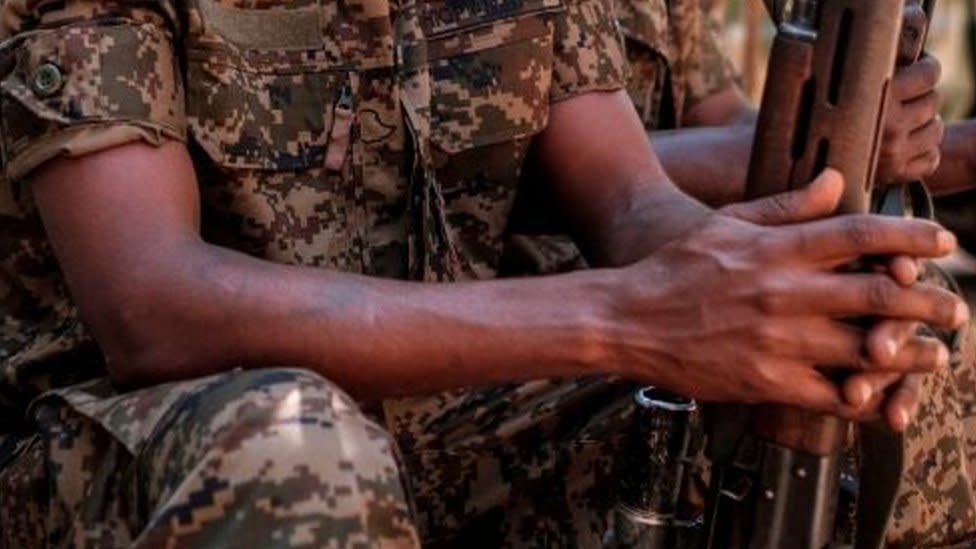
Ethiopia’s military killed more than 40 men suspected of being linked to the massacre of at least 100 people, including children, in the Benishangul-Gumuz region, state media reports.
Five current and former government officials were also detained due to the security crisis, the reports add.
The attackers set fire to the homes of sleeping villagers and shot and stabbed people in Wednesday’s attack.
The attack came a day after Prime Minister Abiy Ahmed visited the region.
It is not clear who the attackers were, but they appear to have targeted ethnic minority communities seen as “settlers” in the region, said the human rights group Amnesty International.
Ethiopia has seen an increase in political, ethnic and religious violence in recent years.
It had the largest number of internally displaced people in Africa in 2018 – about 1.8 million.
Conflicts have been largely fueled by groups that demand more land and power, with attempts to expel people they consider strangers.

Abiy described the massacre as tragic and said the government had sent a force to the area to help find a solution to the conflict.
State media did not release the identity of the 42 people killed in the military operation to pursue the attackers.
According to the report, weapons, including bows and arrows, were seized.
A deputy government minister was among the five people arrested, state media reported.
Some of the five were “allegedly involved in [the] security crisis “while others were detained because they allegedly” did not fulfill their responsibilities properly “, the reports say.
What happened during the last attack?
A spokesman for the Ethiopian Human Rights Commission, linked to the state, told the BBC that gunmen carried out the attack in western Benishangul-Gumuz around 4 am local time (1 am) on Wednesday.
“They went down to a village and while their victims slept, they set fire to their houses, but they also shot and killed civilians,” said Aaron Maasho.
Amnesty International said it had spoken to five survivors and an official who reported that members of the Gumuz ethnic community attacked the homes of people from the Amhara, Oromo and Shinasha communities.
“While Amnesty International is unable to verify the identities of the perpetrators, this attack appears to be the most recent target of ethnic minority people in the area.
“With dozens still missing and houses still on fire, the death toll is likely to increase and there must be an urgent investigation into this horrendous attack,” he added in a statement.
What is the big picture?
Ethiopia is the most populous state in Africa after Nigeria. It has a population of more than 100 million divided into about 80 ethnic groups.

Abiy became prime minister in 2018 after mass protests forced his predecessor to step down.
He promised to end the authoritarian regime and introduced comprehensive reforms that led to the banning of political groups and the release of thousands of prisoners.
The end of state repression also led to a wave of ethnic nationalism, which turned into violence.
Ethnic and political groups that felt repressed under the previous regime demanded more autonomy for their regions and greater recognition of their linguistic and cultural rights.
Is the violence linked to the conflict in Tigray?
No, but the region’s now deprived ruling party, the Tigray People’s Liberation Front (TPLF), saw Abiy as a threat to the “ethnic federalism” it helped introduce into Ethiopia after it came to power at the end of a guerrilla war in 1991.
He had created the Revolutionary Democratic Front of the Ethiopian People (EPRDF), a coalition of four ethnic-based parties, to govern in the center.
Abiy ended the coalition last year, replacing it with his new Prosperity Party (PP).
For him, the PP helps to forge unity by bringing together ethnic-based parties from across Ethiopia.
But, unlike the other three coalition parties, the TPLF refused to dissolve and merge with the PP.
This led to a permanent break in relations between the two sides, and the TPLF was not represented in the federal government for the first time since 1991.
The party withdrew to its Tigray regional stronghold and held regional elections in September, challenging the federal decision to postpone all elections due to the coronavirus outbreak.
This marked a significant escalation in tensions, which eventually led to the outbreak of the conflict in Tigray last month.
Hundreds, or even thousands, are believed to have died in that conflict, while around 50,000 fled to neighboring Sudan.
